Buddhism In Queens
Visakha Puja – Buddhist Holy Day
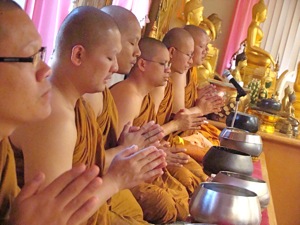 The full moon of the fifth lunar month is the most important holy day in the Buddhist religion. It is the anniversary of the birthday, the enlightenment and the death of Siddhartha, who became the awakened one or the enlightened one and began teaching Buddhism over two and a half thousand years ago.
The full moon of the fifth lunar month is the most important holy day in the Buddhist religion. It is the anniversary of the birthday, the enlightenment and the death of Siddhartha, who became the awakened one or the enlightened one and began teaching Buddhism over two and a half thousand years ago.
Buddhist Temples In Queens
There are about 23 Buddhist temples in Queens, of which more than half are located in Flushing; with the next largest grouping of them in the Elmhurst / Woodside area. The Buddhist temple I visited on this holy weekend, Wat Buddha Thaithavornvanaram, is located in Elmhurst on 46th Avenue near 76th Street. The temple was founded in 1994 and is open for traditional services to all who wish to attend.
Buddhist Services – In Thai & English Languages
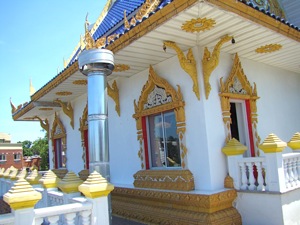 The service I attended was given largely in the Thai language, but the primary monk, Phrakhu Tawin, frequently spoke in the English language for long periods of time, so I was able to get a flavor for what was being said in the service. I also conversed with a number of the parishioners during the meal, all of who spoke English. Most of the folks with whom I conversed had come from Thailand, Sri Lanka, and Bangladesh. I estimate there were some 200 or more people in attendance, including some of European descent.
The service I attended was given largely in the Thai language, but the primary monk, Phrakhu Tawin, frequently spoke in the English language for long periods of time, so I was able to get a flavor for what was being said in the service. I also conversed with a number of the parishioners during the meal, all of who spoke English. Most of the folks with whom I conversed had come from Thailand, Sri Lanka, and Bangladesh. I estimate there were some 200 or more people in attendance, including some of European descent.
Buddhism – A Brief History
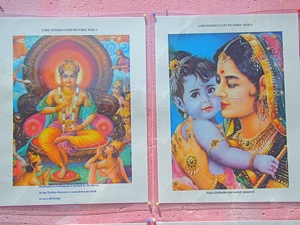 Traditionally Buddhism is practiced in Nepal, the birthplace of Buddha, before he became the enlightened one. Buddhism is also practiced in northern India where Buddha traveled and eventually died. Over the years Buddhist teachings spread to Bangladesh [once a part of India], Myanammar [once called Burma], Thailand, Sri Lanka, Vietnam, China, the Korean peninsula and Japan.
Traditionally Buddhism is practiced in Nepal, the birthplace of Buddha, before he became the enlightened one. Buddhism is also practiced in northern India where Buddha traveled and eventually died. Over the years Buddhist teachings spread to Bangladesh [once a part of India], Myanammar [once called Burma], Thailand, Sri Lanka, Vietnam, China, the Korean peninsula and Japan.
Buddhism encompasses about 350 million people worldwide, with a growing number of Buddhists coming from western cultures. It is believed that part of this trend stems from the congruence of many Buddhist teachings with some of the tenets of modern science.
Buddhism – In Elmhurst / Woodside / Queens
 Buddhist teachings are encapsulated in the four noble truths, which state that: 1) suffering is an inherent part of living, 2) the origins of suffering is ignorance, 3) ignorance that one’s suffering is caused by attachment to physical objects, and 4) suffering can be eliminated by following the right path in life.
Buddhist teachings are encapsulated in the four noble truths, which state that: 1) suffering is an inherent part of living, 2) the origins of suffering is ignorance, 3) ignorance that one’s suffering is caused by attachment to physical objects, and 4) suffering can be eliminated by following the right path in life.
Buddhist teachings then prescribe the Noble or righteous path to end suffering. The path includes the following ‘Right’: 1) understanding, 2) thought, 3) speech, 4) action, 5) effort, 6) livelihood, 7) mindfulness, and 8) concentration.
Buddhist Services – Elmhurst, Queens, NY
There were numerous occasions where the monks would chant in unison, from which  emanates an interesting communal human vibration. Having taken traditional yoga classes that include chanting, this vibration was not unfamiliar to me. It generates a very subtle and unusual feeling, reaching into a part of my being with which I am only vaguely familiar.
emanates an interesting communal human vibration. Having taken traditional yoga classes that include chanting, this vibration was not unfamiliar to me. It generates a very subtle and unusual feeling, reaching into a part of my being with which I am only vaguely familiar.
In his talk / sermon, the primary monk told us that the things you do, good or bad, reflect what is in your heart and will come back to you. When you hurt someone else, you’re hurting yourself. When you help someone, you’re helping yourself. I asked around and it appears that Buddhists, like Hindus, believe in karma. One’s karma brings good or bad things into one’s life. Buddhists also believe that everything is connected, such as the past being connected to the present and will be to the future.
Buddhism and Modern Science – Congruence
 Buddhist teachings appear to be in alignment with many scientific concepts. The idea of things coming back to you appears in sync with the old Newtonian axiom that: for every action there is an opposite and equal reaction [Isaac Newton]. As for universal connectedness, it’s worth noting that about ten years ago scientists discovered that the planet is permeated by a matrix of extremely tiny, sub atomic particles with virtually no mass, which constitute a radiation blanket of neutrinos which are constantly passing through all of us at the speed of light and thereby, in some sense, connecting all of us together.
Buddhist teachings appear to be in alignment with many scientific concepts. The idea of things coming back to you appears in sync with the old Newtonian axiom that: for every action there is an opposite and equal reaction [Isaac Newton]. As for universal connectedness, it’s worth noting that about ten years ago scientists discovered that the planet is permeated by a matrix of extremely tiny, sub atomic particles with virtually no mass, which constitute a radiation blanket of neutrinos which are constantly passing through all of us at the speed of light and thereby, in some sense, connecting all of us together.
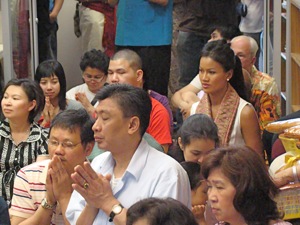 The principal of the temple school sat down with me for a while to explain the importance of the holiday and the significance of some of the ceremonial rites. He also noted that the Buddha instructed his disciples to reject the infallibility of doctrinal teachings, unless they corresponded with one’s own experience. When in doubt, the Buddha instructed his disciples to investigate things to try to find the truth. This teaching also appears to be in alignment with the scientific approach which constantly challenges established beliefs and assumptions which haven't been proven, or for which new theories emerge when new evidence becomes known.
The principal of the temple school sat down with me for a while to explain the importance of the holiday and the significance of some of the ceremonial rites. He also noted that the Buddha instructed his disciples to reject the infallibility of doctrinal teachings, unless they corresponded with one’s own experience. When in doubt, the Buddha instructed his disciples to investigate things to try to find the truth. This teaching also appears to be in alignment with the scientific approach which constantly challenges established beliefs and assumptions which haven't been proven, or for which new theories emerge when new evidence becomes known.
Buddhists also believe in reincarnation. They, like Hindus, believe that one lives many lives, paying for the misdeeds of the past, or reaping the benefits of the good deeds done before. While there's no known scientific evidence supporting reincarnation per se, it is a well known principle of physics that nothing is ever lost - only transformed. For example water evaporates to steam and then condenses as moisture or rain. And when wood or coal are burned, they don't disappear, but rather the molecular structure is transformed to free up energy. So while we may one day die, that which we are, will only be transformed into something else [and in the Buddhist belief system - someone else].
Buddhist Monks - Contemplative Lifestyle
The Buddhist monks live an ascetic and contemplative lifestyle, essentially repudiating the material world. The monks eat only one meal a day and are reliant upon the beneficence of others for food, clothing and shelter. The monks meditate frequently, quieting their minds, to contemplate humanity and existence. The monks main responsibility is to carry on the work of Buddha by keeping his teachings alive.
Buddhist & Christian Services – Some Similarities
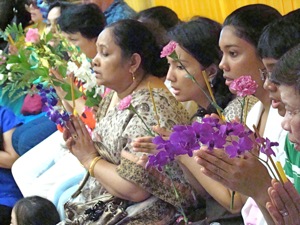 I found myself comparing the Buddhist service to my own experiences in the Christian tradition. The monks would chant and the temple members would follow with a chorus, much like in the Christian religion where the priest may say or sing certain statements, which are followed by a vocal response from the parishioners.
I found myself comparing the Buddhist service to my own experiences in the Christian tradition. The monks would chant and the temple members would follow with a chorus, much like in the Christian religion where the priest may say or sing certain statements, which are followed by a vocal response from the parishioners.
For the most part the temple parishioners would kneel or sit, oftentimes with their hands folded in prayer. The primary monk gave a speech, which seemed to have elements comparable to taking excerpts out of the gospel and then giving a sermon. The structure of the talk / lecture seemed a bit more free flowing than what I’ve witnessed in the Christian tradition, but this was my first effort covering a Buddhist service, so I can’t be sure of that.
Visakha Puja – Holiest Day In Buddhist Year
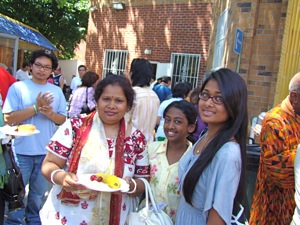 The service was preceded by a giving of alms on this important day. The alms included primarily food which was given to the monks in a formal procession [see slide show below]. The food was then transferred into large boxes. A lunch was served in the temple courtyard following the first segment of the service. It was a near perfect summer day, with a gentle wind blowing through the yard. It was during this time that I photographed the upper temple where the flower and candle ceremony would soon follow.
The service was preceded by a giving of alms on this important day. The alms included primarily food which was given to the monks in a formal procession [see slide show below]. The food was then transferred into large boxes. A lunch was served in the temple courtyard following the first segment of the service. It was a near perfect summer day, with a gentle wind blowing through the yard. It was during this time that I photographed the upper temple where the flower and candle ceremony would soon follow.
During the flower ceremony, the monks lead the congregation around the temple three times before entering to make the offering. The monks were followed by women wearing white robes, many of whom had come to the temple during this important holiday to spiritually cleanse themselves. The symbolism of circling the temple three times is to commemorate: 1) the Buddha, 2) Dharma which means ‘the right way’ or managing oneself in congruence with Buddhist teachings, and 3) the monks who have the responsibility of carrying on Buddhist teachings.
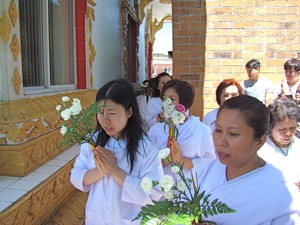 The women wear the white robes as a symbol of spiritually cleansing themselves during this important holy day. Many spend extra time at the temple meditating. The significance of the flowers and candles is that these things are temporary – flowers die and candles burn out. The message here is that the teachings of the Buddha must also be renewed or they too will die out.
The women wear the white robes as a symbol of spiritually cleansing themselves during this important holy day. Many spend extra time at the temple meditating. The significance of the flowers and candles is that these things are temporary – flowers die and candles burn out. The message here is that the teachings of the Buddha must also be renewed or they too will die out.
Wat Buddha Thaivornvanaram Temple – Elmhurst
The Wat Buddha Thaihavornvanaram temple offers Buddhist classes for children on Saturdays from 1 – 3 pm from September through May and for adults on Sundays from 1 – 3 pm year round. They also hold services regularly and can be reached at this telephone number 718.803.9881.
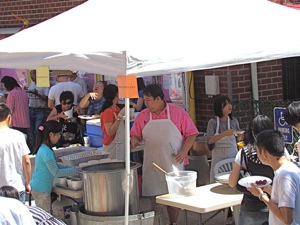 Many thanks to the primary monk, Phraku Tawin, the school principal Tongchai Ouicharen, Mr Thee of Arunee Thai restaurant, and all of the fine people I met who were so gracious during my brief visit.
Many thanks to the primary monk, Phraku Tawin, the school principal Tongchai Ouicharen, Mr Thee of Arunee Thai restaurant, and all of the fine people I met who were so gracious during my brief visit.
SEE SLIDE SHOW BELOW.
Jackson Heights Neighborhood - Related Links
Click this link to go to the Jackson Heights & Elmhurst Neighborhood News / Jackson Heights & Elmhurst Restaurants Guide & Map / Jackson Heights Business Directory / Elmhurst Business Directory / Jackson Heights & Elmhurst Shopping Center & Map.
$element(ophoto,photo_slideshow,75,550,,5.00,fade)$
Queens Buzz Site Search. 1) for best results, when typing in more than one word, use quotation marks - eg "Astoria Park" and 2) try both singular and plural when searching for a specific item such as "gym" or "gyms".
$element(bwcore,insert_search,N)$
Send this story to a friend by filling in the appropriate box below.











